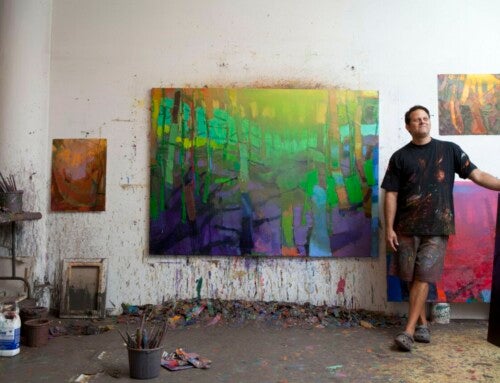Masterpieces are made by channeling genius through tools – paintbrushes, pens, chisels and trumpets. Nafees Bin Zafar’98 uses a keyboard and mouse.
He creates visual effects for Hollywood – scenes so riveting they rival the finest paintings, prose, sculpture and jazz.
Careful, you might choke on your popcorn.
by Jason Ryan
photography by Ric Frazier
For a man who works in movies, visual effects wizard Nafees Bin Zafar ’98 doesn’t exactly give himself the Hollywood treatment. Visit his website, and the first thing you’ll see is a biographical statement that’s hardly blockbuster material:
I can read and write code. That about sums it up.
Except, it doesn’t sum it up. Doesn’t even come close.
If you want to know the story of Nafees, maybe it’s best to try that old Tinseltown trick, and fit his life into one of a variety of recycled storylines.
He could be the Asian whiz kid who becomes a college freshman at age 16, and finishes his computer science degree in three years. He could also be an only child in a Muslim family that immigrates to the South, leaving behind an impoverished country for a land of opportunity (and a healthy dose of culture shock). Or maybe you like the one where Nafees graduates from college and joins a crack squad of rogue computer experts who mysteriously operate out of an apartment with computer hardware stacked in the kitchen.
Take your pick – they’re all accurate.
But wait, there’s more to the story. We’ve neglected the parts where he found community at the College of Charleston through high-end computers and bad Chinese food. How he disappointed his parents with his career choice, but redeemed himself by winning an Academy Award for visual effects. How he spends his spare time reading physics journals and reusing formulas devised by 1950s government scientists. And how the magical scenes he whips up through keystrokes – creating on-screen cyclones, floods, infernos and end-of-earth waterfalls – are so realistic they threaten to make nearly every aspect of traditional filmmaking superfluous. After all, who needs actors, sets, scenery and lighting when a computer can make them for you cheaper?
So reading and writing code hardly sums it up, and Nafees’ story doesn’t fit neatly into traditional Hollywood narratives. That’s okay. If you’re desperate for a metaphor, consider looking at Nafees’ life through the medium he operates in: code. Like any person, there have been glitches in his life, and times when he’s needed to reprogram himself. But so long as he’s had a computer at his fingertips, there’s been nothing he couldn’t fix.
***
If you watch movies, chances are you’ve seen Nafees’ work. He develops software for visual effects company Digital Domain in Venice, Calif., and his specialization is fluid simulation, or the creation of computer graphics featuring water, smoke, explosions and related effects. In 2008, he and colleagues Doug Roble and Ryo Sakaguchi won a Scientific and Technical Academy Award for developing fluid simulation software used in movies that include The Lord of the Rings: The Fellowship of the Ring, Pirates of the Caribbean: At World’s End, Flags of Our Fathers and The Day After Tomorrow. 
Scientific and Technical Academy Awards are lovingly referred to as the geek’s Oscars, but unlike their dramatic counterpart, they’re not required to be given annually. Only breakthroughs of considerable merit are recognized, and only after they’ve proven their value for a number of years.
It’s difficult to imagine Nafees winning an Academy Award if, two decades earlier, his parents had not decided to move their family from Bangladesh. Longing for better economic opportunity, they moved to the United States after Nafees’ father retired from the Bangladesh Army as a lieutenant colonel. In Bangladesh, people are lucky to have access to the Internet, nevermind having the opportunity to become an expert in computers and programming. According to 2007 estimates, about .3 percent of the population has access to the Internet in Bangladesh, or 500,000 people in a country of 154 million. About 23 percent of the population has some kind of phone.
So in 1989, Nafees’ family left Bangladesh’s capital, Dhaka, for Charleston, where Nafees’ father could earn an M.B.A. at The Citadel. Nafees was 11 years old.
Though their future brimmed with possibility, Nafees and his parents had left behind everything that was familiar. In Charleston, they had no relatives or friends. Unlike some larger American cities, Charleston had no Bangladeshi expatriate community, either, and few Muslims. His parents, both workaholics by Nafees’ account, continually impressed upon young Nafees the sacrifices the three of them had made.
Such a plunge into the unfamiliar, however, was the best thing that could happen, says Nafees. It forced him to assimilate into American culture faster, and prompted him to be friendly. Nafees became a standout student in Charleston schools, skipping two grades to graduate from Charleston’s Academic Magnet High School at age 16. Next, he enrolled at the College, where his father was an adjunct accounting professor. His parents had dreams of him becoming a doctor, which, says Nafees, “is a common desire for a lot of South Asian parents.”
Nafees didn’t share the same goal. He was bored by labs and neglected his assignments.
“I was actually a terrible student,” Nafees says of his college days. “It’s not that I wasn’t interested, I just wasn’t doing my classwork.”
The kid genius’ grades started to slump. Mom and Dad were seeing the American dream go up in smoke, their sacrifices being made for naught.
“They kept trying to get me to take life seriously,” Nafees says. “They were worried.”
***
Nafees begins each job by reading a script.
Next, he looks at a movie’s storyboard. Between the two, he’ll have a sense of what he and his co-workers at Digital Domain are expected to produce – what incredible effect they’ll need to simulate. For Pirates of the Caribbean: At World’s End, he helped create a waterfall that cascades off the end of the earth. For Flags of Our Fathers, an explosive-laced, smoke-filled attack on Iwo Jima. For The Day After Tomorrow, a flood that courses through the streets of Manhattan.
Moviemakers have turned to digital effects in recent decades for a multitude of reasons, but usually when they need to create effects that are physically impossible, fantastic, excessively expensive or extremely dangerous. Nafees recalled a time not too long ago when movie studios would simulate floods by building a large tank of water and unleashing a deluge on model buildings.
“You spent a lot of time and money building these miniature sets,” he says. “It’s very expensive and time consuming, and you have no control over it. You have one take.”
Just like Hollywood’s traditional talent – actors, directors, cinematographers and screenwriters – visual effects experts have the ability to create some of films’ most memorable features, including the entrancing stop-motion skeleton battle in the 1963 classic Jason and the Argonauts, the buzzing light sabers and zooming starfighters of the original Star Wars trilogy, the terrorizing T-1000 of the Terminator series and the larger-than-life dinosaurs in Jurassic Park.
In February, Nafees’ colleagues at Digital Domain won an Academy Award for visual effects in The Curious Case of Benjamin Button. For 52 minutes of the film, they placed a computer-generated head atop an actor’s body, allowing the character to be shown at different stages of his life as he aged in reverse, from old to young.
Many agreed that Digital Domain successfully crossed what’s known as the uncanny valley – a phenomenon identified in 1970 by robotist Masahiro Mori, who hypothesized that the closer a robot or animation resembles a human, the more glaring its deficiencies become. In other words, it’s the difference between seeing a robot with human-like characteristics, which can be cute and pleasing, and a near-human that seems a bit soulless or robotic, which can be uncomfortable to watch.
In crossing the uncanny valley, many critics have said that Benjamin Button achieved the holy grail of visual effects, creating a computer-generated actor that passes muster as a human. Nafees agrees with this assessment, but says his company’s feat has just created a new starting point.
“Benjamin Button went a long way,” Nafees says, “but I think there’s more to be done.”
***
Computer science saved Nafees.
Though it’s one of the smaller departments at the College, with 15 to 30 graduates each year, and its cutting-edge culture may seem at odds with a campus that prides itself on history, it was a perfect fit for Nafees. The computer lab became a second home. There, the upperclassmen were inviting, and the professors friendly. Classes were small and intimate. “It was like getting coffee,” Nafees says of lectures.
The commands Nafees entered on machines produced results that fascinated him. He was charting his own course.
“I realized I didn’t like wet lab work – doing things physically,” Nafees says. “Computer science had this instant gratification thing.”
With the College’s acquisition of two computer graphics workstations in 1996, his future in computer science was cemented. His parents could kiss their doctor dreams goodbye. Nafees became obsessed with the Silicon Graphics Inc. machines. He created fractals – eye-popping geometric shapes and patterns – using relatively simple math. His mind was racing at the possibilities. Computer science professor Anthony Leclerc, who obtained grants to buy the machines, says he soon “gave him the keys” and named Nafees the system administrator for the SGI machines. As one friend says, “Nafees was always on one of them.”
When Nafees wasn’t creating graphics, he was collaborating with classmates in programming competitions. And when he wasn’t doing that, he was likely playing video games, like Quake or Duke Nukem, with friends in the computer science department.
“They worked hard, they played hard,” says Leclerc, who was occasionally roped into one of their LAN (local area network) parties to play games. “I was just sort of mediocre in their company.”
The gang of computer enthusiasts met so regularly they even gave themselves a formal name: the Won Ton Clan.
“They had their own little club, as bizarre as it sounds,” says Leclerc. “It gave them a social structure, a bubble. They got some toys to play with. It was their little, mini MIT.”
***
I think there’s more to be done.
That statement is essentially Nafees’ mantra. After the script and storyboards, Nafees researches what has been done before. Then he seeks ways to improve on that work.
On his desk are important resources: stacks of scratch paper, where he can put down his thoughts and there’s a small library of books, scientific journals and research papers. He works in reverse, imagining the finished effect, and then figures out how to create it.
“You start with a picture and boil it down to the math,” Nafees says.
Nafees’ computers might be cutting edge, but his most useful math equations are old school, including the Navier-Stokes equations for fluid motion (originated in the 19th century) and a variety of formulas developed by National Laboratories scientists in the 1950s. Because computers were very slow at that time, government scientists created formulas that cut corners, including an “incompressibility cheat,” says Nafees. This formula ignores the fact that water and other fluids can be compressed, simplifying computations with negligible differences in results. The National Labs scientists eventually published a large body of their work, and it’s proven quite useful for visual effects specialists to use decades later.
“We’re able to dig out the cheats, which were no longer good enough for engineering, and use them for digital graphics,” he says.
If you speak to Nafees for a little while, you start thinking there’s probably not much he couldn’t understand. You realize that behind any mediocre grades lies an incredible aptitude.
“He pretty much has taught himself advanced math without a graduate degree,” says friend and former co-worker Nathan Zorn ’00.
***
To trace the origins of the Won Ton Clan, one must sift through the rubble of the Great Wall Chinese Restaurant, which sat on George Street until its demolition several months ago.
It was a favorite haunt of the clan, and the wellspring for many of their inside jokes.
“Terrible Chinese place, but they had a cheap buffet,” says Nafees. “We would go there in large numbers.”
During their visits, Nafees and his friends began noticing a cook sitting alone in a dark booth, striking not only for his Fu Manchu mustache and hardened look, but for the cigarette he held in one hand and the beer in the other – a sight the students found inconsistent with restaurant sanitation. Soon, their imaginations ran wild, and rumors began to swirl. The cook was named Won Ton Jack, and he was a kung fu expert. He had fled China to protect his secret recipe involving unusual chicken organs. He also had a short temper and a vicious kick.
Television episodes were scripted, featuring oddly amusing comments from their combative and gruff hero.
From their pilot of The Great Wall of Death:
Won Ton Jack: I see your kung fu is stinky. I shall now proceed to pulp your body until it closely resembles a slightly soggy, half-eaten egg foo yung patty! Boot to the head!
And:
Won Ton Jack: Although I would rather we drink tea than fight, I must admit I look forward to the opportunity to kick the crap out of every last one of you!
Such college antics were the product of creative and literary college minds looking to let loose, says Nafees. Beyond ravaging the Chinese buffet, the clan regularly patronized Sharky’s Pizza and movie theaters showing kung-fu movies. Today, the 20 or so members of the Won Ton Clan chip in a few bucks a year for space on a server, keeping up a website to “remind us of our silliness,” says Nafees.
They also trade e-mails each day, often sharing tech tips and helping each other problem solve in their jobs, most of which are computer related.
“The group will never shrink and never grow,” says Brian Crawford ’97, a clan member and friend to Nafees. “It will always stay this group of people from college that you trust. It’s pretty special.”
***
Last year, Nafees spoke to a group of recent high school and college graduates. He emphasized the importance of self-learning and understanding things for oneself.
He sympathized that such endeavors might not always be easy:
My advice to you is this … just try something. Trying things is easy! But what if it’s too difficult? Well, then break it down into a problem that is less difficult. But what if you don’t like it? So what? Then you’ll stop. Try something else. Trying different avenues in life has no cost attached. You always learn something, and you always come out ahead.
Nafees told the graduates he learned these lessons from Frank Starmer, his first boss, and one of his most memorable teachers.
Starmer hired Nafees straight out of college as the first member of a freewheeling tech team at the Medical University of South Carolina. The team operated independent of the normal hospital administration, and kept an office in a nearby apartment. Two students worked in one bedroom, two in another, two more in a living room, and computer equipment was stacked in the kitchen. From their cozy office, they devised anything from backup e-mail systems for the university to makeshift firewalls.
Starmer encouraged the team to take chances and be bold. Every Monday, they’d have a show-and-tell session in the apartment, and Starmer would visit to quiz his strike force on their recent work. Starmer and his team would also run across the James Island Connector at lunch time each day to talk shop and exercise. Starmer fought hard to give his tech squad freedom and support.
“If you get a smart group of kids together, point them in the right direction and get out of the way, they’ll do things you never dreamed of,” says Starmer, now the associate dean of learning technologies at Duke–NUS Medical School in Singapore. “I didn’t care what Nafees’ grades were. I cared about his passion, his curiosity and his ability to innovate.”
A few years after Nafees left MUSC for Digital Domain, Starmer received a note from his former employee. In 2005, Starmer had been posting photos online of the construction of the Arthur Ravenel Jr. Bridge, and, apparently, Nafees had been following along:
Hi Frank. I’ve been looking at your cooper river bridge pictures. And I wondered why the tops of the towers were indented, and not flat. I guessed it had to be for aerodynamic reasons, but I couldn’t find anything on the web about the exact reasons. So I ran a simulation.
I’m attaching movies of the top view and the side view of the simulations. The wind is blowing in at about 22 mph. The massless tracer smoke is generated by 2 sources; 1 on top, and 1 on the leeward side. … The vortex shedding frequency seems a little bit higher in the “flat-top” configuration, and downstream the flow is more turbulent. Also, there is a very substantial pressure drop in the indented region. So I suspect that you will have some really good photo-ops of condensation trails on a cold and windy day.
Starmer happily posted the simulations and analysis on his website.
“The kid was just fun to deal with,” he says.
***
It’s in Nafees’ code to tinker.
When he watches scenes of his work in films, he can’t help but see it through a critical lens. There’s always something that stands out to his trained eye, something he could have made better. Watching a scene from Pirates of the Caribbean: At World’s End, he laments how the waves break, how the sea foam looks and how water flows around a boat’s hull.
It looks good, but it’s not perfect.
“I’m happy to say I’m my biggest critic,” he says. “I’m not sure I ever finished anything.”
Nafees works in a technical field, but, he says, “just about anybody can evaluate my work. It either looks good or it doesn’t.”
Nafees’ job is to trick the human brain. The brain is an astute adversary, able to pick up on the slightest abnormalities or physical quirks. Often, people can tell him a scene doesn’t look right, but they can’t say why.
That’s when Nafees must tinker, tweaking the math to make objects speed up, slow down, sink, rise or whatever. Tinker, tinker, tinker.
In recent years, he’s tinkered with his personal life, too, scaling back his hours at work. When he first started at Digital Domain, he says, he wasn’t so good at managing his time.
He’s also become a foodie, cooking more and dining out at premier restaurants. Somewhere, Won Ton Jack and the staff of the Great Wall are crying.
The tinkering has paid off. Nafees has found a career and rhythm that seems to make everyone happy – himself, Hollywood executives and moviegoers the world over.
Even his parents are happy.
“The Academy Award helps,” Nafees says. “They’re no longer disappointed that I did not become a doctor.”




